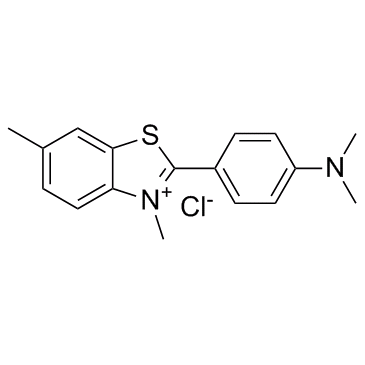Thioflavine T

Thioflavine T structure
|
Common Name | Thioflavine T | ||
|---|---|---|---|---|
| CAS Number | 2390-54-7 | Molecular Weight | 318.864 | |
| Density | N/A | Boiling Point | N/A | |
| Molecular Formula | C17H19ClN2S | Melting Point | 212ºC | |
| MSDS | Chinese USA | Flash Point | N/A | |
|
Posttranslational modification and mutation of histidine 50 trigger alpha synuclein aggregation and toxicity.
Molecular Neurodegeneration 10 , 8, (2015) Aggregation and aggregation-mediated formation of toxic alpha synuclein (aSyn) species have been linked to the pathogenesis of sporadic and monogenic Parkinson's disease (PD). A novel H50Q mutation of aSyn, resulting in the substitution of histidine by glutam... |
|
|
β-cyclodextrin and curcumin, a potent cocktail for disaggregating and/or inhibiting amyloids: a case study with α-synuclein.
Biochemistry 53(25) , 4081-3, (2014) Aggregation of α-synuclein has been implicated in Parkinson's disease (PD). While many compounds are known to inhibit α-synuclein aggregation, dissolution of aggregates into their constituent monomers cannot be readily achieved. In this study, using a range o... |
|
|
Microglia constitute a barrier that prevents neurotoxic protofibrillar Aβ42 hotspots around plaques.
Nat. Commun. 6 , 6176, (2015) In Alzheimer's disease (AD), β-amyloid (Aβ) plaques are tightly enveloped by microglia processes, but the significance of this phenomenon is unknown. Here we show that microglia constitute a barrier with profound impact on plaque composition and toxicity. Usi... |
|
|
Curcumin binds to the pre-fibrillar aggregates of Cu/Zn superoxide dismutase (SOD1) and alters its amyloidogenic pathway resulting in reduced cytotoxicity.
Biochim. Biophys. Acta 1854(5) , 426-36, (2015) Amyotrophic Lateral Sclerosis (ALS) is a fatal neurodegenerative disease that affects motor neurons. Unfortunately, effective therapeutics against this disease is still not available. Almost 20% of familial ALS (fALS) is suggested to be associated with pathol... |
|
|
Adsorption and sub-nanomolar sensing of thioflavin T on colloidal gold nanoparticles, silver nanoparticles and silver-coated films studied using surface-enhanced Raman scattering.
Spectrochim. Acta. A. Mol. Biomol. Spectrosc. 149 , 949-56, (2015) Raman and surface-enhanced Raman scattering (SERS) studies of thioflavin T (ThT) in solid, solution, gold nanoparticles (GNPs), silver nanoparticles (SNPs) and silver-coated films (SCFs) were investigated. Concentration-dependent SERS spectrum of ThT in GNPs ... |
|
|
A comparative study on the aggregating effects of guanidine thiocyanate, guanidine hydrochloride and urea on lysozyme aggregation.
Biochem. Biophys. Res. Commun. 450(4) , 1339-44, (2014) Protein aggregation and its subsequent deposition in different tissues culminate in a diverse range of diseases collectively known as amyloidoses. Aggregation of hen or human lysozyme depends on certain conditions, namely acidic pH or the presence of additive... |
|
|
Thermally induced degradation pathways of three different antibody-based drug development candidates.
Eur. J. Pharm. Sci. 62 , 148-60, (2014) Protein-based medicinal products are prone to undergo a variety of chemical and physical degradation pathways. One of the most important exogenous stress condition to consider during manufacturing, transport and storage processes is temperature, because antib... |
|
|
Vicenin 2 isolated from Artemisia capillaris exhibited potent anti-glycation properties.
Food Chem. Toxicol. 69 , 55-62, (2014) Vicenin 2, isolated from a traditionally used medicinal plant Artemisia capillaris, is a 6,8-di-C-glucoside of apigenin which has been previously reported to possess a wide variety of pharmacological activities including antioxidant, anti-inflammatory, anti-c... |
|
|
Tyrosine- and tryptophan-coated gold nanoparticles inhibit amyloid aggregation of insulin.
Amino Acids 47 , 2551-60, (2015) Here, we have strategically synthesized stable gold (AuNPs(Tyr), AuNPs(Trp)) and silver (AgNPs(Tyr)) nanoparticles which are surface functionalized with either tyrosine or tryptophan residues and have examined their potential to inhibit amyloid aggregation of... |
|
|
Self-assembly of a nine-residue amyloid-forming peptide fragment of SARS corona virus E-protein: mechanism of self aggregation and amyloid-inhibition of hIAPP.
Biochemistry 54(13) , 2249-61, (2015) Molecular self-assembly, a phenomenon widely observed in nature, has been exploited through organic molecules, proteins, DNA, and peptides to study complex biological systems. These self-assembly systems may also be used in understanding the molecular and str... |